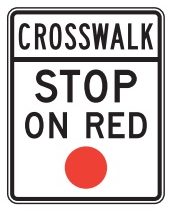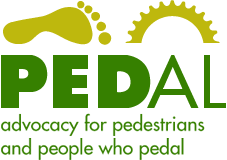Kill SB 986 Before it Kills Us
♥ Just in time for Back to School: the “California Stop” may be legal soon. Let’s hope not ♥
♥ Public Action Needed: Read below and Email your California Assembly office ♥ Wednesday, August 3rd, California’s Assembly Appropriations Committee considers CVC changes.
Proposed amendments to California Vehicle Code sections 21453, 21971, and 42001.15 threaten public safety, especially kids walking and biking. Here’s why:
Existing law, CVC section 21453, requires motorists approaching a red light to stop and remain stopped at the limit line, or if no line, at the nearest crosswalk, or if none, before entering the  intersection. Thereafter, they can proceed only when it’s safe to do so, i.e., AFTER they check for oncoming pedestrians, bicyclists, and cars.
intersection. Thereafter, they can proceed only when it’s safe to do so, i.e., AFTER they check for oncoming pedestrians, bicyclists, and cars.
SB 986 strikes the mandate in 21453’s first paragraph, which requires drivers to remain stopped UNTIL they LOOK FIRST. The phrase, “remain stopped,” is eliminated from circular red light situations (but is unchanged for red arrows; there, drivers must stay put until the signal permits movement). That seemingly small change effectively legalizes the “California stop” at red lights, allowing motorists to look left while turning right.
SB 986 law breakers get a 65% discount off today’s citation. The $45 street sweeping parking ticket in San Clemente will be more than an SB 986 violation ($35). No kidding . . .
SB 986 fails to consider our typical wide, arterial roads where cars in adjacent lanes obstruct a motorist’s view. With 2-5 lanes in each direction, edging forward is always dicey. Add a slight curve and/or a few parkway plants and/or a truck . . . even the safest drivers have a hard time seeing what’s coming, especially kids. “Remain stopped” in existing law is important.
Motorists won’t stop until it’s too late. Most parents instruct their kids to stay out of the road and bike and skate on the sidewalk. Most kids don’t understand the dangers of sidewalk riding, especially when going against vehicular traffic. Kids think a green light means “go” and fly from curb to curb. Approaching the intersection from a motorist’s right, then entering the crosswalk is deadly because motorists often don’t look right for oncoming cars; they look left.
And lives are ruined.
Orange County is unsafe enough: we’re among the 5 worst of 58 counties statewide for speed related collisions (see Calif Office of Traffic Safety). Between 2008-2013 11,638 people were killed and injured on Orange County roads. Here’s the 2008-2013 Statewide Integrated Traffic Records System (SWITRS) data for OC:
- 230 total pedestrians killed + 4,735 pedestrians injured
- 57 total bicyclists killed + 6,616 bicyclists injured
Of those, Child victims (ages 0-19, 2008-2013) in Orange County number:
- 22 child pedestrians killed + 1,854 child pedestrians injured
- 10% of pedestrian deaths and 39% of pedestrian injuries were kids aged 0-19 years.
- 6 child bicyclists killed + 2,441 child bicyclists injured
- 10% of bicyclist deaths and 37% of bicyclist injuries were kids aged 0-19 years.
More than 1/3 of Orange County’s injury collisions were caused by drivers failing to yield to people in crosswalks. Crosswalk striping is often ineffective under existing law. California motoring culture is already renowned for gliding around corners without regard to intersections’ limits.
Here’s what SB 986 proposes to legalize (via David Huntsman at bikenewportbeach.org):
That’s costly. In May, 2015, the National Highway Traffic Safety Administration published its revised “The Economic and Societal Impact of Motor Vehicle Crashes, 2010.” The U.S. Department of Transportation now recommends the latter for guidance on risk reduction, approximating the value of a statistical life as $9 million in 2010-12. Here’s what that meant nationwide in 2010:
- $16 billion in economic costs due to cars hitting bicyclists and pedestrians only (not including car vs. car).
- $87 billion in comprehensive costs (economic impacts + lost quality of life), also due to cars hitting bicyclists and pedestrians only.
California is the worst in the nation in economic losses caused by all types of vehicle collisions (again, estimated for 2010 by the NHTSA study, page 145):
- $20,000,000,000 California
- $17,000,000,000 Texas
- $15,000,000,000 New York
Quickly estimating the costs of OC’s pedestrian and bicyclist deaths 2008-2013:
- 287 deaths x $9M = $2,583,000,000 or $2.58 Billion
Who pays?
- 54% private insurers
- 23% government
- 16% employers, health care providers and charities in lost work and unpaid medical bills.
- 7% individuals
In 2010 alone, our country lost more than $100 billion because cars hit bicyclists and pedestrians. You don’t have to walk or bike to get the point.
Alternatively, $20B builds 20,000 miles of Class 1 car-free bike/ped paths. Want traffic to improve? Build Class 1’s so walking and biking is safer.
SB 986 may make local traffic control more expensive, too. Post SB 986, if a city wants to require a stop before the limit line, a city might need to replace the existing circular signal with a right turn signal because that part of CVC 21453 will remain unchanged. Since signals are synchronized to optimize traffic flow, changing one signal affects movement in every direction.
Will SB 986 force cities to change all the signals at a particular intersection? Maybe. If so, it costs about $300,000 to signalize an intersection; ten intersections is $3 million. Can we really afford that? Should we? From that perspective, SB 986 is plain dumb.
Contact your California Assembly member to oppose SB 986.

